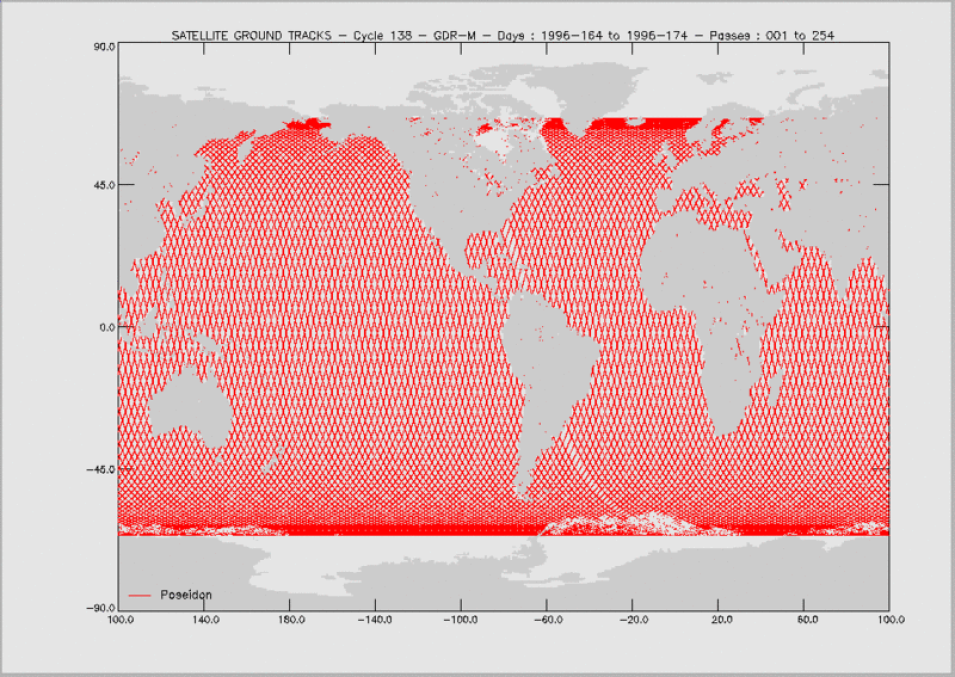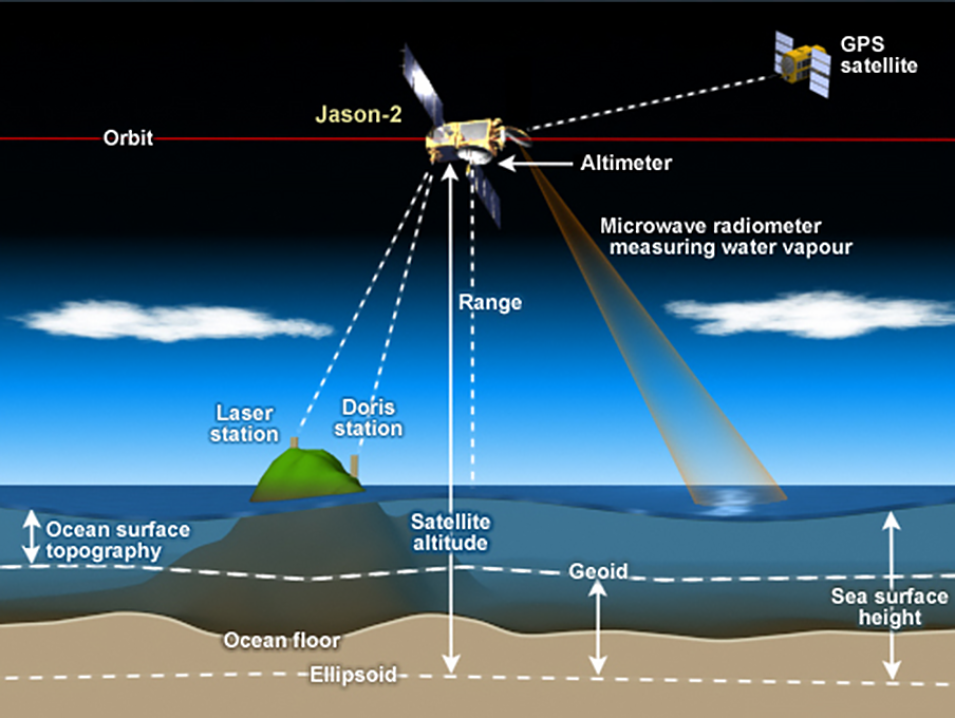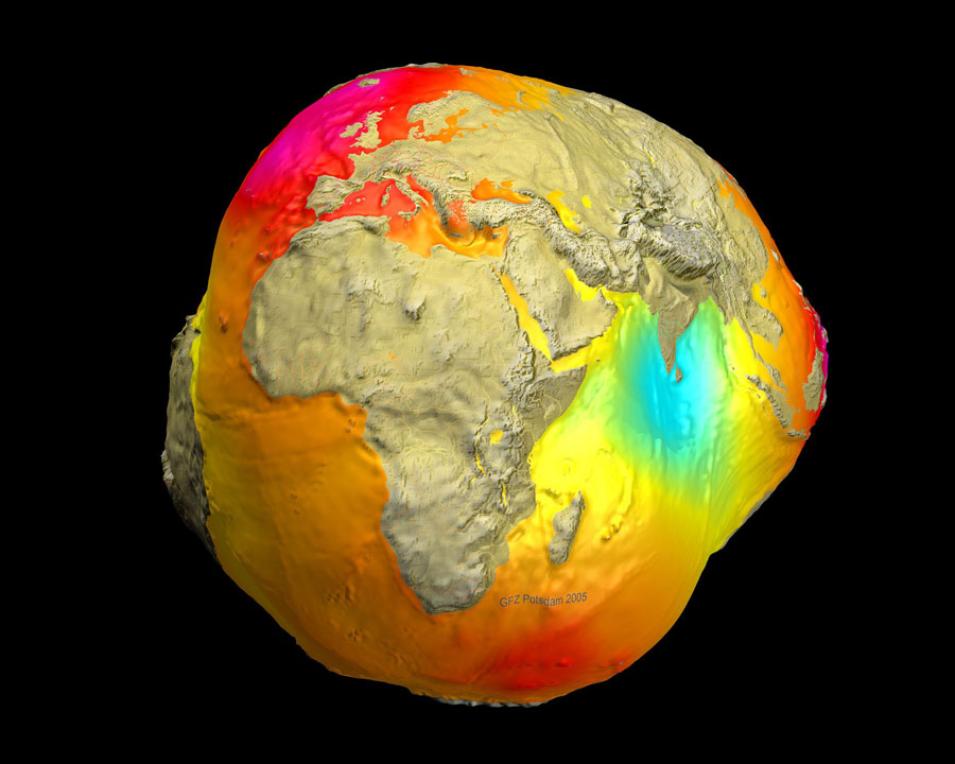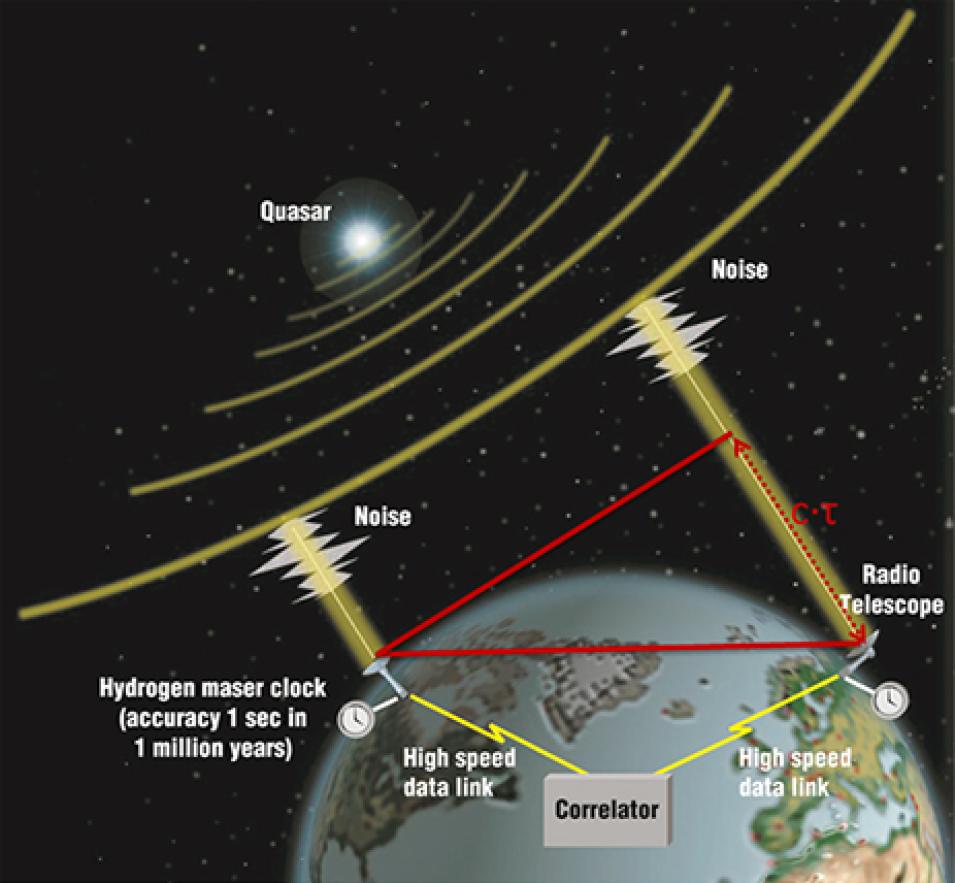For more than 28 years, a series of satellite ocean altimetry missions has compiled a record of sea surface height using the same global observational ground track. Starting with the Topographic Experiment (TOPEX)/Poseidon mission (operational 1992 to 2006) and continuing with the Jason-1, Ocean Surface Topography Mission (OSTM)/Jason-2, and Jason-3 series of satellites (operational 2001 to present), this consistent ocean altimetry data record continues with the launch of the Sentinel-6 Michael Freilich satellite. The result will be a more than 30-year time-series of satellite-acquired sea surface height data.
The Precision Behind Sea Level Rise
Red lines on this world map show the orbital tracks of the TOPEX/Poseidon, Jason-1, OSTM/Jason-2, Jason-3, and Sentinel-6 Michael Freilich ocean altimetry missions. These satellites are used as orbiting tide gauges that provide a snapshot of ocean surface height and pass over the same point every 9.9156 days. The result is a consistent record spanning more than 28 years. Image: AVISO (Toulouse, France).
Sea level change, and the rate of this change, is derived from calculations of sea surface height. By averaging the hundreds of thousands of satellite-collected altimetry measurements acquired over the same orbital track by TOPEX/Poseidon, the Jason series of satellites, and, now, Sentinel-6 Michael Freilich, global mean sea level can be determined with a precision of several millimeters along with its change over time.
“Sea surface height is telling you what the height of the water column is,” explains Jessica Hausman, support scientist for NASA’s Physical Oceanography Program. “There are a lot of factors that influence sea level change. You have water inputs from land, from glaciers, you have thermal expansion, and you have changes caused by differences in salt concentrations.”
The fact that an altimeter aboard a satellite orbiting hundreds of miles above Earth and travelling tens of thousands of miles per hour can acquire accurate measurements of the range from the satellite to the ocean’s surface is an indication of the incredible precision that is required – and achieved – in knowing the exact position of the satellite above a stable reference point on Earth. The technique for accomplishing this is called Precise Orbit Determination (POD).
POD is part of the Earth science discipline of geodesy, which is concerned with the shape, gravity field, and rotation of Earth and how these variables change over time. The process of POD involves doing a summation at every time step of all the forces acting on a spacecraft, and integrating equations of motion to determine the exact position of an orbiting satellite where a measurement is taken. As noted by Dr. Frank Lemoine, a geodesist with NASA’s Space Geodesy Project and a member of NASA’s Ocean Surface Topography science team, “If you don’t do POD right, you’re not going to get any sea level results.”
Click on image for larger view. Image: NASA's Jet Propulsion Laboratory (JPL) and available at https://sealevel.jpl.nasa.gov/missions/technology/.
And doing POD right requires numerous inputs. Here’s where an image comes in handy (see illustration at right). As the OSTM/Jason-2 satellite (operational 2008 to 2019) shown in the image orbited 830 miles above Earth, its altimeter acquired range measurements from the satellite to the ocean’s surface over the same locations every 9.9156 days – the same repeat time and orbital track as TOPEX/Poseidon, Jason-1, Jason-3, and Sentinel-6 Michael Freilich.
Determining the exact position of the satellite when an observation is acquired entails the use of several space geodetic techniques. A retroreflector attached to the satellite reflects laser beams that are directed toward it by satellite laser ranging (SLR) stations on the ground (Laser Station in the image). Altimeter satellites are tracked by a global network of stations operated by NASA and other countries organized under the aegis of the International Laser Ranging Service (ILRS).
Along with a retroreflector, Jason-2 also carried a Doppler Orbitography and Radio-positioning Integrated by Satellite (DORIS) receiver that detected radio signals broadcast by DORIS beacons on the ground (DORIS Station in the image). A third tracking system aboard the satellite was a global positioning system (GPS) receiver that used signals from a constellation of orbiting GPS satellites to determine the satellite’s position (GPS Satellite in the image; GPS is the U.S. version of the Global Navigation Satellite System [GNSS]). TOPEX/Poseidon, Jason-1, Jason-3, and Sentinel-6 Michael Freilich all carried or carry DORIS and GPS receivers along with retroreflectors.
For ground-based geodetic stations like SLR and DORIS, the exact position of the station must be known. This is accomplished through the use of the Terrestrial Reference Frame (TRF). The TRF consists of a set of coordinates and velocities of reference points on Earth’s surface whose positions are known very accurately as a function of time. These points define a realization of a spatial reference system that makes it possible to not only relate geodetic measurements from different stations, but have these measurements linked over space and time. Since Earth’s tectonic plates are constantly moving, both horizontally and vertically, a realization of the TRF is re-calculated on a regular basis (typically every five to six years).
The TRF enables the precise positioning of geodetic stations that are used to calculate the position of a satellite in space. “Without a terrestrial reference frame, you’re not going to be able to reliably determine mean sea level or interpret what you’re actually seeing,” says Dr. Lemoine.
Knowing where the satellite is through the use of SLR, DORIS, and GPS is only half the battle. The next step is determining the exact satellite altitude and, through this, sea surface height. Both the satellite altitude and sea surface height are calculated with respect to a solid, stable reference point called the ellipsoid.
Talking about the ellipsoid means we need to talk about Earth’s shape. Contrary to what you may have heard (or seen in the shape of just about any schoolroom globe), our planet is not a perfect sphere. The shape is more like a ball with someone sitting on it – flatter at the top with a bulge in the middle. This resulting slightly-squashed shape is called an ellipsoid.
The reference ellipsoid is a smoothed mathematical representation of Earth’s sea level surface that ignores the effects of tides, seasonal currents, and waves. It is from this smooth, consistent surface that satellite altitude and sea surface height are calculated.
“This is our starting point for all measurements,” says Jessica Hausman. “TOPEX and all the Jason satellites used this same reference ellipsoid. This means that regardless of the satellite, we always have the same starting point.”
It’s important to remember that that when we talk about sea surface height, we’re not talking about the distance from the satellite to the surface of the water – this is the range. Sea surface height, on the other hand, is the combination of the geoid and the ocean’s dynamic topography (which includes tides, seasonal currents, and waves).
A geoid image of Earth showing Earth’s gravity field anomalies as of 2005. This image, known as the Potsdam Gravity Potato, shows areas where Earth’s gravity field is higher (darker colors) and areas where the gravity field is lower (lighter colors). Image credit: NASA, CHAMP, GRACE, GFZ, DLR.
The geoid relates to Earth’s gravity field. Gravity is not constant across Earth, and the amount of force exerted by gravity changes with changes in mass. These uneven mass distributions influence satellite trajectories since areas of higher mass exert more force than areas of lower mass (from Newton’s Second Law of Motion: Force = mass x acceleration or F = ma).
If tides and currents (the dynamic ocean surface topography) were removed from the ocean, Earth would have an undulating shape, with hills of higher mass concentrations where the force of gravity is higher and valleys of lower mass concentrations where the force of gravity is lower. This irregular shape is called the geoid. Without a good model representing the distribution of Earth’s mass, your satellite position will be in error. As noted by Dr. Lemoine, prior to the launch of TOPEX/Poseidon, errors in models of Earth’s gravity field were the largest source of orbit error for satellite altimeter missions.
Fortunately, orbiting satellites are able to provide precise measurements of how Earth’s mass is distributed. Models of Earth’s gravity field used for POD are based primarily on data from the joint NASA/German Aerospace Center (DLR) Gravity Recovery and Climate Experiment (GRACE; operational 2002 to 2017), the joint NASA/German Research Centre for Geosciences GRACE-Follow On (GRACE-FO; launched in 2018), and the European Space Agency's Gravity field and Ocean Circulation Explorer (GOCE; operational 2009 to 2013). Additional gravitational data are acquired by satellite laser ranging measurements to geodetic satellites, such as the LAser GEOdynamics Satellite (LAGEOS) and the LAser RElativity Satellite (LARES).
While the single GOCE spacecraft carried a gradiometer to acquire data, GRACE and GRACE-FO feature identical twin satellites flying in formation. By continually measuring minute changes in the distance between the two satellites to an accuracy of one micron (about 70 times smaller than the average diameter of a human hair), areas of higher and lower mass concentrations can be identified. Data from GOCE, GRACE, and GRACE-FO enable the determination of not just where mass concentrations are higher or lower, but also how mass is redistributed as fluid moves around Earth’s surface and within the planet.
GRACE and GRACE-FO products also include snapshots of mass change on different temporal and spatial scales, including mass changes resulting from glacial rebound, hydrology changes on land surfaces and in river basins, and movement of ice sheets and glaciers. Model information from the GRACE missions, including these time-variable gravity variations, are used to create better models of spacecraft trajectory. In fact, if these models were not included in POD determinations, the calculated rates for mean sea level change would be off by a few tenths of a millimeter per year.
As you might infer from the above paragraphs, the geoid (unlike the ellipsoid) is not constant – and is anything but smooth. The geoid typically varies on the order of +/- 100 meters over the globe, sometimes running above the ellipsoid and sometimes below the ellipsoid. The ocean’s dynamic surface topography extends from the top of the geoid to the ocean surface and varies on the order of about two meters.
Here’s how everything comes together. The sea surface height is the combination of the geoid and the dynamic surface ocean topography. The satellite altitude over the ocean is the distance from the satellite to the ellipsoid. If you want to deduce the shape of ocean currents and how these change with time (the dynamic ocean surface topography), simply eliminate the geoid from the sea surface height determination. Dr. Lemoine points out that missions like GRACE, GRACE-FO, and GOCE have a direct benefit in that they enable a better calculation of ocean currents from satellite altimetry data, and an indirect benefit in that their data enable geodesists to more precisely calculate satellite trajectories.
But there are still forces acting on the planet and on the orbiting satellite that can affect the actual position of the altimeter in space. For one, the atmosphere itself has mass and, through this, its own gravity field (the force of which is constantly changing). To account for this, space geodesists acquire numerical weather model output every three hours that transforms pressure fields into gravitational coefficients. These atmospheric gravitational coefficients are incorporated into the POD analysis.
And as Earth rotates about its axis, it also is wobbling. This leads to changes in the position of the center of rotation, or what we know as the Pole. Polar motion, the motion of Earth’s rotational axis relative to its crust, can shift on the order of five to six meters. For this reason, the exact position of the Pole must be determined every day, primarily through GNSS (which can determine this to a few millimeters). As Dr. Lemoine points out, “If you don’t model polar motion, then the location of your ground stations relative to your satellite could be in error by up to five or six meters.”
An additional variable that needs to be considered for POD is changes in Earth’s rotation. Not only is Earth rotating about a wobbling axis, but the speed of this rotation is slowing down. As noted above, the planet has areas of higher and lower mass concentrations that vary across its surface and are constantly shifting. As mass concentrations shift, this changes the distribution of mass relative to the planet’s rotational axis and affects the speed of the planet’s rotation. Even through these changes in rotational speed are on the order of tenths of milliseconds, this effectively changes the length of day by approximately one millisecond per year. This may not sound like much, but this translates to about 46 centimeters in longitude at the equator. As a result, changes in Earth’s rotation with time are determined daily and input into POD.
How VLBI works. Differences in the time of arrival of radio signals emitted by a quasar detected by two radio telescopes enable the determination of a baseline that can be used to calculate minute changes in Earth’s rotational speed. Click on image for larger view. Image from NASA’s Space Geodesy Project website.
Determining changes in Earth’s rotation requires a specialized geodetic technique called Very Long Baseline Interferometry, or VLBI. VLBI uses pairs of radio telescopes to detect radio signals emitted by distant quasars. By measuring the difference in arrival time of a radio signal from a specific quasar being observed simultaneously by two radio telescopes, changes in Earth’s rotation over time can be calculated. Depending on the networks or number and type of radio telescopes used, this can be determined with a precision of 5 to 15 microseconds.
When it comes to forces acting directly on the satellite, a real issue in POD is the effect of radiation pressure. Radiation pressure is the force exerted by photons (packets of light energy) on the spacecraft. While the primary source of photons is the Sun, they also can be reflected from Earth.
As these photons hit the spacecraft, this radiation pressure can cause slight changes in the spacecraft’s trajectory. As a result, POD calculations have to account for whether the spacecraft is in full Sun or in Earth’s shadow. While the most sophisticated models use a form of ray-tracing, Dr. Lemoine notes that POD calculations generally settle on the simplest modeling that satisfies how well the spacecraft trajectory needs to be calculated.
Geodetic techniques like SLR, GNSS, DORIS, and VLBI constantly are improving. More detailed information about these techniques is available through NASA’s Crustal Dynamics Data Information System (CDDIS), which is the NASA Earth Observing System Data and Information System (EOSDIS) Distributed Active Archive Center (DAAC) responsible for NASA geodetic data. In addition, satellite altimetry and sea surface height data in the EOSDIS collection are freely available through NASA’s Physical Oceanography DAAC (PO.DAAC).
Along with a retroreflector, star trackers, and a DORIS receiver, the Sentinel-6 Michael Freilich satellite also carries the next generation of GNSS receiver that enables the satellite to acquire signals from both the U.S. GPS and the European Galileo GNSS constellations. “This enables you to calculate the position of the satellite using two different GNSS constellations to see how well they agree” says Dr. Lemoine.
The enormous amount of time devoted to the calculations involved in POD ensure a consistent, scientifically accurate satellite altimetry record dating back to the early-1990s and a reliable assessment of the rate of sea level rise. Through the use of geodetic techniques and data from satellite missions like GOCE, GRACE, and GRACE-FO, the continuous satellite altimetry record initiated by TOPEX/Poseidon and the Jason series will continue with Sentinel-6 Michael Freilich well into the 21st century.
Additional Resources
POD Earthdata Webinar with Dr. Frank Lemoine: https://youtu.be/w6TwpsnFkis
NASA CDDIS Geodetic Techniques page: https://cddis.nasa.gov/Techniques/index.html
NASA PO.DAAC Ocean Surface Topography page: https://podaac.jpl.nasa.gov/OceanSurfaceTopography





